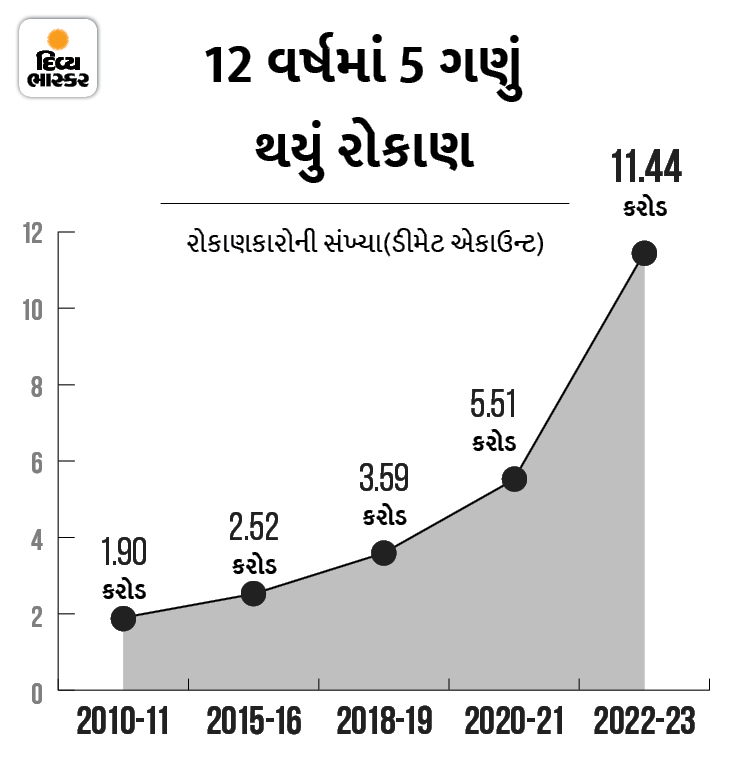સ્થાનિક શેરબજાર આજે ઐતિહાસિક ઊંચાઈને સ્પર્શી ગયું છે અને તેની નવી ઓલ ટાઈમ હાઈ બનાવી છે. આજે સવારે કારોબાર શરૂ થયાના એક કલાકમાં જ સેન્સેક્સે રેકોર્ડ ઉંચી સપાટી બનાવી છે. સેન્સેક્સે આજે તેની 63583ની ભૂતપૂર્વ ઊંચી સપાટીને પાર કરી છે
1. What is the Stock Market?
The stock market refers to a marketplace where buyers and sellers trade shares of publicly listed companies. It provides a platform for companies to raise capital by selling shares, while investors can buy and sell those shares to participate in the potential growth of the companies. The stock market serves as a barometer of economic health and a source of investment opportunities for individuals and institutions alike.
2. The Role of Stock Exchanges
Stock exchanges are the primary venues where stock market transactions occur. They provide the necessary infrastructure and regulations to facilitate trading. Prominent stock exchanges include the New York Stock Exchange (NYSE) and the Nasdaq Stock Market in the United States, as well as the London Stock Exchange, Tokyo Stock Exchange, and others worldwide.
3. Types of Stocks
Stocks, also known as equities or shares, represent ownership in a company. There are various types of stocks, including common stocks and preferred stocks. Common stocks grant shareholders voting rights and potential dividends, while preferred stocks offer priority in receiving dividends but generally lack voting rights.
સેન્સેક્સે 6 મહિના પછી નવો રેકોર્ડ બનાવ્યો:ટ્રેડિંગ દરમિયાન 63 હજાર 588ના સ્તરે પહોંચ્યો, આ પહેલાં ડિસેમ્બરમાં ઊંચકાયો હતો
વિસ્તાર માં માહિતી વાંચો

15 વર્ષમાં માર્કેટ 10 હજારથી 60 હજાર સુધી પહોંચી ગયું
25 જુલાઈ, 1990ના રોજ, BSE સેન્સેક્સ પ્રથમ વખત 1 હજારની સપાટીને સ્પર્શ્યો હતો. 1 હજારથી 10 હજાર (6 ફેબ્રુઆરી 2006) થવામાં લગભગ 16 વર્ષ લાગ્યાં. પરંતુ 10 હજારથી 60 હજાર સુધીની સફર માત્ર 15 વર્ષમાં પૂર્ણ થઈ હતી.


અને 63,588.31ની નવી ટોચ બનાવી છે. અગાઉ નિફ્ટીનું રેકોર્ડ ઉચ્ચ સ્તર શું હતું? અગાઉ, શેરબજારમાં નિફ્ટીનું રેકોર્ડ ઉચ્ચ સ્તર 18,887.60 હતું, જે 1 ડિસેમ્બર, 2022ના રોજ નિફ્ટીએ સ્પર્શ્યું હતું. જ્યારે સેન્સેક્સે 63,583.07ની ઊંચી સપાટી દર્શાવી હતી. બજાર છેલ્લા ઘણા દિવસોથી સેન્સેક્સ-નિફ્ટીની ઐતિહાસિક ટોચે પહોંચવાની રાહ જોઈ રહ્યું હતું અને સેન્સેક્સ માટે આ રાહ પૂર્ણ થઈ છે.
હજુ પણ નિફ્ટીની ઓલ ટાઈમ હાઈની રાહ જોવાઈ રહી છે સેન્સેક્સે આજે 63,583ની ઊંચી સપાટી વટાવીને 63,588.31ની નવી ઐતિહાસિક ટોચને સ્પર્શી હતી અને હવે બજાર રાહ જોઈ રહ્યું છે કે નિફ્ટીમાં ક્યાં સુધી રેકોર્ડ હાઈ લેવલ જોવા મળે છે.
આજે, નિફ્ટી 18,875.90 સુધી પરત ફર્યો પરંતુ હજુ સુધી ઐતિહાસિક ઊંચાઈને પાર કરી શક્યો નથી. મીડિયા અને નાણાકીય શેરોમાં જબરદસ્ત ઉછાળો મીડિયા શેરોમાં 2.26 ટકાનો જબરદસ્ત ઉછાળો જોવા મળી રહ્યો છે અને નાણાકીય શેરોમાં 1.05 ટકાનો શાનદાર ઉછાળો નોંધાઈ રહ્યો છે. બેન્ક નિફ્ટી પણ જબરદસ્ત વૃદ્ધિ સાથે 43,848 ના સ્તર પર કારોબાર કરી રહ્યો છે.
સેન્સેક્સ-નિફ્ટી શેરની સ્થિતિ આજે સેન્સેક્સના 30 શેરોમાંથી 16 શેરોમાં તેજી સાથે અને 14 શેરો ઘટાડા સાથે કારોબાર કરી રહ્યા છે. બીજી તરફ, નિફ્ટીના 50 શેરોમાંથી 25 શેરો ઉપર છે અને 25 શેર ડાઉન છે, એટલે કે સમાનતાનો મામલો છે. આજે બજારનું ઓપનિંગ કેવું રહ્યું? બીએસઈના 30 શેરોવાળા ઈન્ડેક્સ સેન્સેક્સે આજે 63,467.46 ના સ્તર પર કારોબારની શરૂઆત દર્શાવી હતી. આ સિવાય એનએસઈનો 50 શેરવાળો ઈન્ડેક્સ નિફ્ટી તેજી સાથે 18,849.40 ના સ્તર પર ખુલ્યો છે.
4. Understanding Stock Prices
Stock prices are determined by supply and demand dynamics in the market. Factors such as company performance, industry trends, and market sentiment influence stock prices. Investors analyze stock prices to make informed decisions about buying or selling shares.
5. Fundamental Analysis: Evaluating Companies
Fundamental analysis involves assessing a company’s financial health, business model, competitive advantage, and growth prospects. By examining financial statements, industry trends, and management competence, investors can gauge the intrinsic value of a company’s stock and make informed investment decisions.
6. Technical Analysis: Analyzing Price Patterns
Technical analysis focuses on studying historical price and volume data to predict future price movements. Traders and investors use charts, indicators, and patterns to identify trends and potential entry or exit points. While not without controversy, technical analysis provides insights into market sentiment and can complement fundamental analysis.
7. Common Investment Strategies
Investors employ various strategies to achieve their financial goals in the stock market. These include value investing, growth investing, income investing, and momentum trading. Each strategy has its own set of principles and requires careful consideration of individual risk tolerance and investment objectives.
8. Long-Term Investing vs. Day Trading
Long-term investing aims to generate wealth over an extended period by holding stocks for years or even decades. In contrast, day trading involves buying and selling stocks within a single trading day, capitalizing on short-term price fluctuations. Both approaches have their merits and risks, and choosing the right strategy depends on individual preferences and resources.
9. Risk Management and Diversification
Risk management is crucial in stock market investing. Diversification, spreading investments across different assets and sectors, helps mitigate risks associated with individual stocks. Additionally, setting clear investment goals, establishing stop-loss orders, and conducting thorough research are vital risk management practices.
10. Investing in Index Funds and Exchange-Traded Funds (ETFs)
Index funds and ETFs offer investors a convenient way to gain exposure to a broad market index or specific sectors. These passively managed funds aim to replicate the performance of an underlying index, providing diversification and potentially lower fees compared to actively managed funds.
11. The Impact of Economic Factors on the Stock Market
The stock market is influenced by various economic factors, including interest rates, inflation, GDP growth, and geopolitical events. Understanding the interplay between these factors and stock market performance is crucial for investors seeking to make informed decisions.
12. IPOs and Secondary Offerings
Initial Public Offerings (IPOs) occur when a company sells shares to the public for the first time. IPOs provide an opportunity for investors to participate in a company’s early growth stage. Secondary offerings, on the other hand, involve the issuance of additional shares by an already public company.
13. The Psychology of Market Movements
Investor psychology plays a significant role in stock market movements. Fear, greed, and herd mentality can lead to market bubbles or crashes. Understanding and managing emotions is vital for investors to avoid irrational decision-making and stay focused on long-term goals.
14. Tax Considerations for Stock Market Investors
Stock market investments have tax implications. It’s essential for investors to be aware of capital gains tax, dividends tax, and other relevant tax regulations in their jurisdiction. Consulting with a tax professional can provide valuable guidance in optimizing tax efficiency.
15. Resources for Stock Market Research
There is a plethora of resources available to help investors conduct thorough research and make informed investment decisions. These include financial news outlets, company annual reports, stock market analysis websites, and investment education platforms. Leveraging these resources enhances investors’ knowledge and empowers them to make well-informed choices.


Conclusion
The stock market offers vast opportunities for individuals to participate in the growth and prosperity of companies. By understanding the fundamentals, employing sound investment strategies, and managing risks effectively, investors can navigate the complexities of the stock market with confidence. Remember, investing requires patience, discipline, and continuous learning. Start small, gain experience, and gradually build your investment portfolio to achieve your financial goals.
FAQs
1. How much money do I need to start investing in the stock market?
The amount of money needed to start investing in the stock market varies depending on your financial situation and investment goals. Some brokerage firms offer the option to open an account with no minimum deposit, allowing you to start with small amounts.
2. Are stock market investments guaranteed to make a profit?
No, stock market investments are not guaranteed to make a profit. The stock market involves risks, and the value of stocks can fluctuate. It’s important to conduct thorough research and diversify your portfolio to manage risks effectively.
3. Can I invest in the stock market without extensive financial knowledge?
Yes, you can invest in the stock market without extensive financial knowledge. However, it’s crucial to educate yourself about investing basics, understand the risks involved, and consider seeking guidance from financial advisors or using investment platforms that provide educational resources.
4. How often should I monitor my stock portfolio?
The frequency of monitoring your stock portfolio depends on your investment strategy and preferences. Long-term investors may choose to review their portfolio periodically, while active traders may monitor their positions more frequently. It’s essential to strike a balance between staying informed and avoiding excessive trading based on short-term market fluctuations.
5. Is it possible to lose all my money in the stock market?
While it is possible to lose money in the stock market, the likelihood of losing all your money is relatively low if you follow prudent investment practices. Diversification, thorough research, risk management, and a long-term perspective can help mitigate the risk of significant losses.


